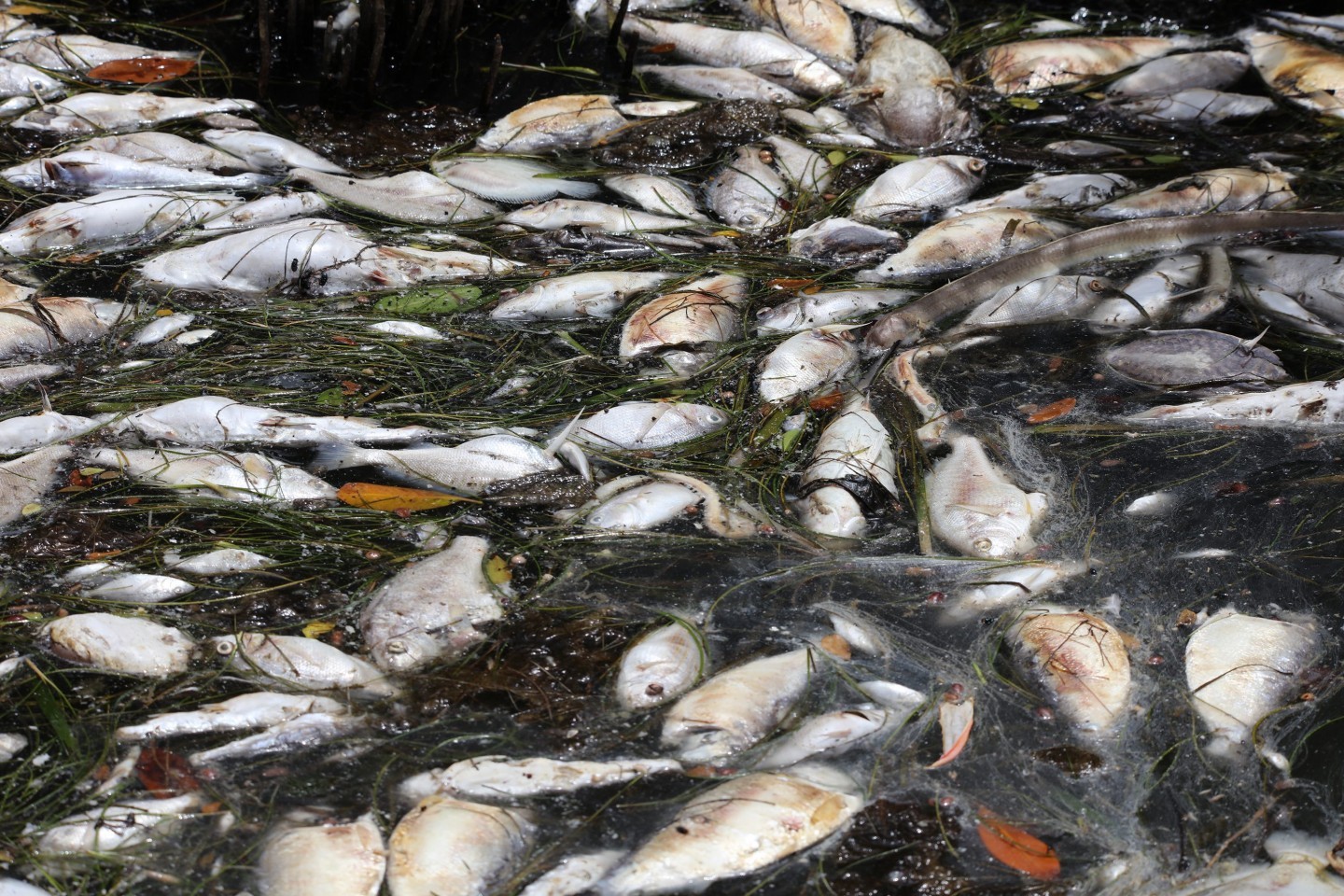
Communities along the Gulf Coast of Florida have been experiencing catastrophic impacts of an unusually persistent, toxic red tide for an entire year now. Red tides are devastating for fish and wildlife and cause health impacts for humans as well.
Additionally, the Panhandle of Florida, which began experiencing impacts from red tide a few weeks ago, is now being forced to deal with massive destruction from Hurricane Michael. The Surfrider Foundation expresses our deepest sympathy for all those who have lost their homes, power, water and other life-sustaining necessities, and to those who are still surviving the aftermath.
While the heavy rains and strong winds caused by the hurricane may have temporarily disrupted the massive algae blooms in the Gulf of Mexico by churning up the water, this reprieve might only be short-lived as coastal flooding and runoff caused by the storm will likely wash even more bloom-fueling pollution out to sea. Learn more about the likely impacts of Hurricane Michael on Florida's red tide here.

Meanwhile the unusual red tide conditions that have caused beach closures from St. Lucie County through Miami-Dade on the Atlantic coast seem to be continuing to spread up and down the coast, with measurable levels of the red tide organism Karenia brevis showing up as far south as the Keys, and as far north as Brevard County. Red tide is different from the blue green algae/cyanobacteria blooms that have impacted Lake Okeechobee and the Caloosahatchee and Indian River estuaries, though many of the health and environmental impacts are similar.
Fish, manatees, dolphins and turtles have been washing up dead on Florida's beaches, and residents and visitors alike are feeling the effects of blooms several blocks inland from the beach as they breathe air contaminated with aerosol toxins released by blooms churned up in the surf. Red tides can cause respiratory and skin irritations, and burning eyes. Health authorities have issued beach closures to protect the public from these health conditions.
 Lifeguards wear masks at Midtown Beach in Palm Beach County on Sunday, September 30, 2018. photo by Melanie Bell @ The Palm Beach Post
Lifeguards wear masks at Midtown Beach in Palm Beach County on Sunday, September 30, 2018. photo by Melanie Bell @ The Palm Beach Post
While the beaches have become unsuitable for animals and humans, the businesses in the affected communities suffer as well. Florida's economy is largely dependent on tourism, and visitors are wisely choosing to change their plans and stay away from the affected beaches. Lifeguards with facemasks are pretty good indicators that the beach is not safe for you and your family!
What can we do to prevent Red Tides and other Harmful Algae Blooms from threatening our coastline?
Red tides are naturally occurring, but there is ample evidence that shows nutrient pollution can fuel blooms, making them larger and longer lasting. Learn more about this here. Worse still, warming waters associated with climate change appear to be helping these blooms thrive in areas that haven't been affected by algae blooms historically.
The nutrient pollution that fuels algal blooms comes from many different sources- runoff from agriculture and landscaping fertilizers, leaky septic tanks and aging sewage infrastructure, and stormwater and urban runoff. And we all can take steps to curb these sources of pollution and support clean water at the beach.

Federal Legislative Action Needed:
At the end of September, Congress let the national algal bloom research and prevention program expire. The U.S. Senate has passed legislation to reauthorize the program, but we also need the House to pass legislation for it to go into effect! The Harmful Algal Bloom and Hypoxia Research and Control Amendments Act of 2017 (S.1057), sponsored by Senator Bill Nelson, extends reauthorization of the program until 2022; requires an assessment of harmful algal blooms resulting from Lake Okeechobee discharges; and establishes a process to allow algal blooms and hypoxic events to be declared an Event of National Significance. We urgently need the House of Representatives to take up and pass S.1057. Click here to contact your member of Congress!
The Florida Legislature can take make a difference by:
- Funding the Florida Healthy Beaches program to test recreational beaches for bacterial indicators of impaired water, Contact your state Senator and Representative and ask for full funding for the Florida Healthy Beaches Program!
- Setting and enforcing strong water quality standards and regulations,
- Helping local communities transition away from septic systems to sewers,
- Provide funding to local municipalities to inspect and maintain their sewage infrastructure.
Local governments can make a difference by:
- Posting beach closures and health advisories quickly and publicly
- Passing strong local fertilizer restrictions, Manatee County is a good example.
- Implementing proactive programs to control stormwater pollution,
- Inspecting and maintaining sewage infrastructure.
Actions we can all take:
- Scoop the Poop. Pick up your pet's waste.
- Wash your car over grass or gravel, not on the street. Better yet keep those suds off your property completely & take your car to a commercial car wash, which collects the wastewater, to keep additional runoff from entering storm drains and local waterways.
- Make your yard more Ocean Friendly.
- Go organic. Stop using chemical fertilizers and pesticides.
- Apply mulch and compost to build healthy living soil instead.
- Plant native and climate-appropriate plants.
- Direct rain gutters and downspouts into your landscaping to slow down and sponge up rain. Learn more here.
If you live in Florida, check bloom conditions at your favorite beach and report any visible conditions or concerns here. Report any illnesses or symptoms you experience by contacting the Florida Poison Control Center at 1-800-222-1222.
More information on the biology and impacts of Red Tide species and Harmful Algal Blooms available on Beachapedia.
